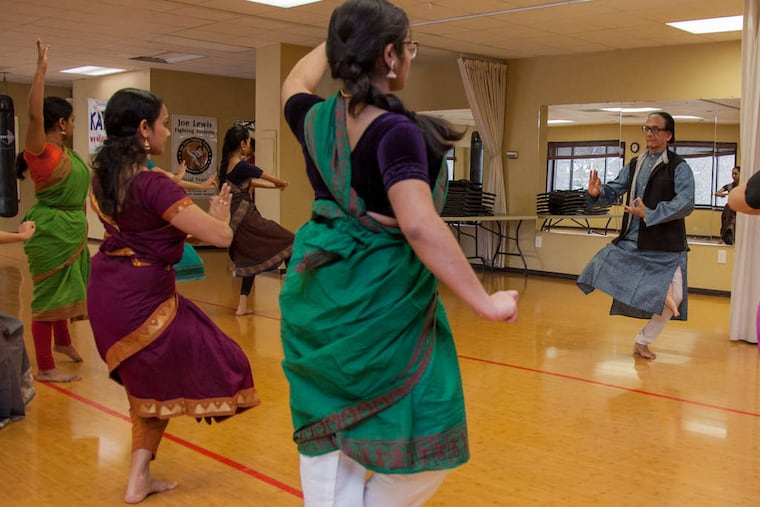Learning 2,000-year-old dance from an Indian master
He would be in town for only two weeks. That meant that area students of Indian classical dance had less than 14 days to be taught by the 79-year-old master.

He would be in town for only two weeks.
That meant that area students of Indian classical dance had less than 14 days to be taught by the 79-year-old master.
So they came from miles away, ages 5 to 55, to learn a 2,000-year-old dance under the instructive eye of C.V. Chandrasekhar of Chennai, India.
"Never try to slide your feet," advised the dancer and choreographer as he demonstrated a graceful hop. "Jump, and you'll be able to find your position."
Chandrasekhar, a scholar and interpreter of Indian classical dance, taught the students Saturday at a studio at a Wayne shopping center during an exclusive U.S. engagement that will culminate in a performance at the Painted Bride Art Center in Philadelphia.
The show and workshops are part of a project developed by Three Aksha, a Philadelphia-based dance academy and performance troupe. Viji Rao, Three Aksha's founder and director, invited Chandrasekhar and his wife, Jaya, a retired dancer, to share their decades of experience with area students.
During lessons, the students learn not only the dance, but also about the instructors' culture and heritage, said Rao, of Philadelphia.
The Chandrasekhars are instructing area students in Bharatanatyam, a form of Indian classical dance that dates to between 500 B.C. and A.D. 500, when women danced for Hindu deities in temples.
At the Painted Bride, C.V. Chandrasekhar will perform the Vibhava, the theory of evolution interpreted in Bharatanatyam dance. He will be joined on stage by the 50 students he has taught during his visit. Shows are scheduled for Friday and Saturday.
The dance project is being funded by the National Endowment for the Arts, the Samuel S. Fels Fund, and the Philadelphia Cultural Fund.
In recent years, Rao said, the popularity of Indian classical dance in America has increased as the Indian community has grown. From 2000 to 2010, the Indian population increased by 70 percent, to more than 2.8 million, according to census figures. In the Philadelphia region, it nearly doubled, to almost 80,000.
Serious dance students often take lessons for up to eight years in preparation for a solo debut, a recital that is called an arangetram.
During workshops, Chandrasekhar, who has won India's highest preforming-arts award, passes down his knowledge of a dance vocabulary that includes 108 postures, eight eye movements, 10 head movements, four neck movements, seven eyebrow movements, and more than 300 hand gestures.
It is a dance that Chandrasekhar continues to perform even after a six-decade career that has included his years as head of the dance department and dean of the performing-arts faculty at the University of Baroda in Gujarat state.
Chandrasekhar took his first lesson as an 11-year-old.
Back then, schoolmates teased him because Bharatanatyam dance was viewed as a woman's art form, even though teachers are often men.
"I was at an age when I didn't know if it was for a woman or a man, I just knew I was interested in music and dance," Chandrasekhar said.
Eventually, his dancing opened doors.
He studied at the Kalakshetra, a school whose mission is to preserve Indian cultural arts. Chandrasekhar became a protege of Rukmini Devi Arundale, who is credited with reviving the popularity of the Bharatanatyam after it became a lost art. Chandrasekhar danced for dignitaries, including the king of Saudi Arabia.
"I finally said, 'Yes, this is what I'm born for,' " Chandrasekhar said.
He later married and crafted a career that included dancing professionally with his wife and his two daughters. Chandrasekhar also choreographs routines and writes music for dance.
He retired from university teaching in 1992, but has continued to lecture, teach workshops, and perform internationally.
"Learning from him is like a divine experience," said Vidya Sukumar, 28, of Allentown. "You see great dancers on stage and appreciate their art. But this is up close and personal, and you can understand what he is trying to communicate in the dance."
On Saturday, Sukumar and eight other dancers rehearsed as a group of excited students awaiting their turns watched through a glass window.
The dancers knelt on the floor in a V formation in front of Chandrasekhar, clad in a blue tunic.
Then in succession, each student performed a series of steps representing different stages in the theory of evolution as South Indian classical music streamed from a boom box.
Chandrasekhar clapped quietly to help students keep the beat, and corrected dancers' positions with a quick touch.
On the verge of 80, Chandrasekhar says he has no plans to retire.
"At this point of my life, I have nothing else in me. My memory sometimes fails, but dance pushes me," Chandrasekhar said. "I think I couldn't have done anything else."
BY THE NUMBERS
300
hand gestures
used by dancers
in Bharatanatyam.
108
postures taken
in the classical Indian dance.
10
head movements
in the dance.
8
eye movements.
7
eyebrow movements.
4
neck
movements.
EndText